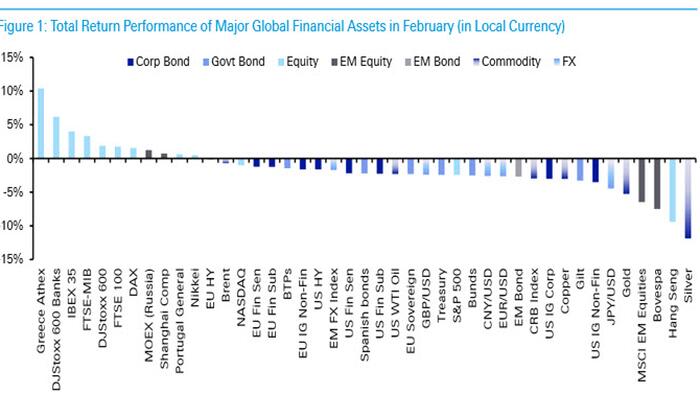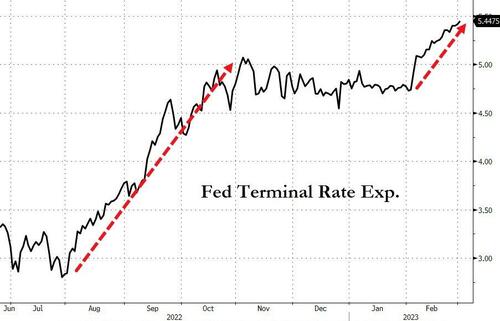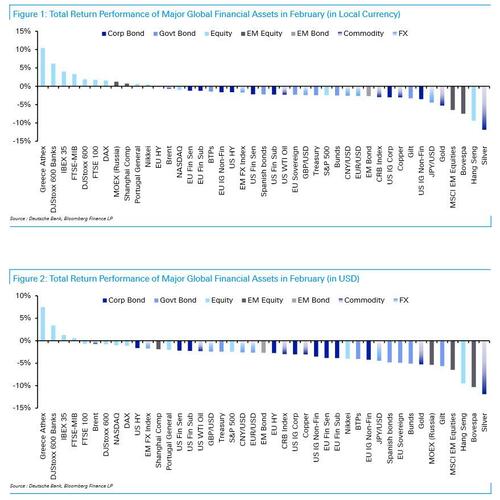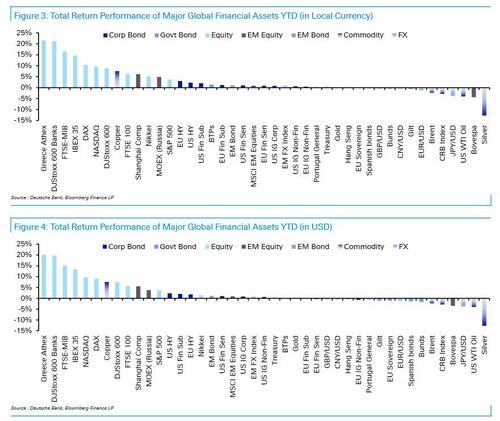


After a very strong start to the year for financial markets, February saw much of the early momentum go into reverse, with losses across equities, credit, sovereign bonds and commodities. That, as DB's Henry Allen explains in his monthly performance review note, came "amidst growing concern about the persistence of inflation, which in turn led investors to ramp up their expectations for central bank rate hikes." When all was said and done, it was an awful month for bonds, with Bloomberg’s global aggregate bond index experiencing its worst February performance since its inception in 1990 just one month after its best ever January. At the same time, February also marked a recovery for the US Dollar, while European equities proved resilient amidst the broader losses elsewhere. Furthermore, the YTD performance of financial assets is still generally positive, with most of those tracked by Deutsche Bank still higher over 2023 so far.
Below we excerpt from DB's Month in Review, starting with the high-level macro overview
Having just experienced a strong rally in January, the initial mood in markets was pretty positive as February began. However, that all changed on the third day of the month, when the US jobs report for January was released. It showed that nonfarm payrolls had risen by credibility-busting 517k in January, marking the strongest job growth in six months. Furthermore, the unemployment rate fell to a 53-year low of 3.4%. The data raised fears that inflation would prove more persistent than previously thought. This led to a sharp re-appraisal on how fast the Fed would be hiking rates, with futures pricing for the December 2023 meeting up by +22.2bps on the day of the jobs report, and then a further +20.5bps on the following Monday. As of today, the terminal rate has shot up by 60bps in the past month, as more than two additional rate have been priced in.
This positive news on the employment side was then followed by upward revisions to inflation data from late-2022. These showed that CPI had fallen less rapidly than thought over Q4, with the 3-month annualized rate of core CPI in December being revised up from 3.14% to 4.25%. Then we had the January CPI data, where headline and core CPI remained hot, as did the PCE measure closely watched by the Fed.
With stronger data on the labor market and inflation, there was growing speculation that the economy could be in for a “no landing” scenario, rather than a hard or a soft landing. Unlike the hard or soft landing, which both see inflation coming down, the “no landing” would involve inflation remaining high, with growth remaining strong, and the Fed needing to hike rates even further in order to bear down on inflation. By the end of the month, this meant that expectations of the Fed’s terminal rate had risen from 4.92% to 5.42%. And if you look at the rate priced by the December 2023 meeting, it went up from 4.48% to 5.28%, an increase of +80.5bps over the month. Investors’ expectations of inflation also saw a sharp move higher, with the 2yr breakeven up from 2.33% to 3.18% over the month.
This trend wasn’t confined in the United States: In the Euro Area, core inflation rose to a new record of +5.3% in January, and initial country releases for February from France, Spain and Germany are still showing high inflation. Similarly, the latest data shows Euro Area unemployment remaining at a joint record low of 6.6% in December, and there was further support on the growth side as natural gas prices declined a further -18.6%. Meanwhile in Japan, headline and core CPI for January reached their highest level since 1981.
The result of all this was a dramatic slide in global bonds. US Treasuries (-2.4%) suffered their worst monthly performance since September, and Bloomberg’s Global Aggregate Bond Index (-3.3%) saw its worst February performance since its inception back in 1990. Equities also struggled, with the S&P 500 peaking for the month on the day before the jobs report came out, before closing -2.4% lower. However, one of the few assets that benefited from this shift in Fed pricing was the US Dollar, with the dollar index (+2.7%) ending a run of 4 consecutive monthly declines.
Which assets saw the biggest gains in February?
Which assets saw the biggest losses in February?
Finally, here is a visual breakdown of the best and worst performing assets in February...
... and YTD.



